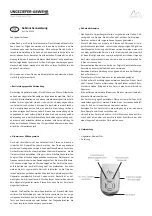
5.4
Autoconfiguration
When autoconfiguration is enabled and no previous autoconfiguration exists, at powerup
the CPU automatically reads the configuration of the modules installed in the system and
creates an overall system configuration. If a previous autoconfiguration is present at
powerup, the configuration is processed as described on the the following sections.
Modules that have software-configurable features use their default settings when
autoconfigured. These features are described in the
VersaMax Modules, Power Supplies,
and Carriers Manual
(GFK-1504).
At powerup, the CPU by default automatically generates a configuration that includes all
of the modules that are physically present in the system, starting at slot 1 of rack 0 (the
main rack). Autoconfiguration of a rack stops at the first empty slot or faulted module and
continues with the next rack. For example, if there are modules physically present in slots
1, 2, 3, 5, and 6, the modules in slots 5 and 6 are not autoconfigured.
To autoconfigure a system with expansion racks, either all racks must be powered from
the same source or the expansion racks must be powered up before the main rack.
5.4.1
Autoconfiguration Assigns Reference
Addresses
Modules are automatically assigned reference addresses in ascending order. For example,
if the system contains a 16 point input module, an 8- point input module, a 16-point
output module, and another 16-point input module, in that order, the input modules are
assigned reference addresses of %I0001, %I0017, and %I0025, respectively. For modules
that utilize multiple data types (for example, mixed I/O modules), each data type is
assigned reference addresses individually.
5.4.2
Autoconfiguration Diagnostics
Module Present But Non-Working During Autoconfiguration
: If a module is
physically present but not working during autoconfiguration, the module is not configured
and the CPU generates an extra module diagnostic.
Empty Slot During Autoconfiguration
: Autoconfiguration of a rack stops at the first
empty slot. Modules located after the empty slot are not autoconfigured. The CPU
generates an extra module diagnostic for each of them.
Previously-Configured Modules Present During Autoconfiguration
:
Previouslyconfigured modules are not removed from the configuration during
autoconfiguration unless no modules are present in the system. For example, if modules
are configured in slots 1, 2, and 3 then power is removed and the module in slot 1 is
removed, when power is reapplied the modules in slots 2 and 3 are autoconfigured
normally. The original module in slot 1 is not removed from the configuration. The CPU
generates a loss of module diagnostic for slot 1.
Different Module Present During Autoconfiguration
: If a slot was
previouslyconfigured for one module type but has a different module installed during
autoconfiguration, the CPU generates a configuration mismatch diagnostic. The slot
remains configured for the original module type.
Unconfigured Module Installed After Autoconfiguration
: If a module that was
not previously-configured is installed-after powerup, the CPU generates an extra module
diagnostic and the module is not added to the configuration.
Configuration
GFK-1503E User Manual 79
For public disclosure
Summary of Contents for VersaMax PLC
Page 16: ...Notes 16 GFK 1503E VersaMax PLC User Manual For public disclosure ...
Page 38: ...Notes 38 GFK 1503E VersaMax PLC User Manual For public disclosure ...
Page 50: ...Notes 50 GFK 1503E VersaMax PLC User Manual For public disclosure ...
Page 92: ...Notes 92 GFK 1503E VersaMax PLC User Manual For public disclosure ...
Page 112: ...Notes 112 GFK 1503E VersaMax PLC User Manual For public disclosure ...
Page 224: ...Notes 224 GFK 1503E VersaMax PLC User Manual For public disclosure ...
Page 292: ...Notes 292 GFK 1503E VersaMax PLC User Manual For public disclosure ...
Page 316: ...Notes 316 GFK 1503E VersaMax PLC User Manual For public disclosure ...
Page 317: ......
















































